KINGENE Technology BT410D01 Bluetooth USB Bongle User Manual
KINGENE Technology Corporation Bluetooth USB Bongle
User Manual
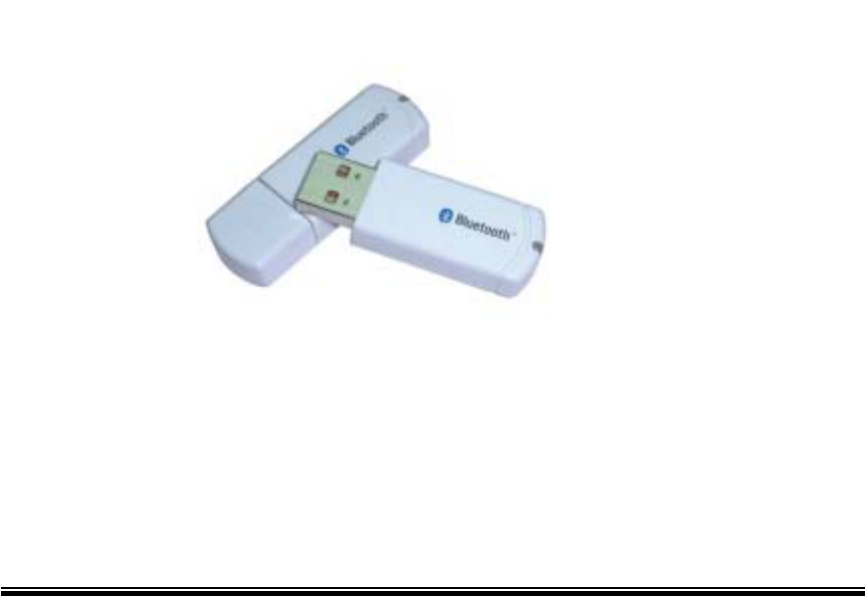
Bluetooth USB Dongle
User Guide
1
DECLARATION
All the parts of this product, including accessory、software and this
user guide, are owned by us. Any transmitted、 transcribed、imitated,
or translated into any language in any form or by means without
permission from us are illegal.
The specification and information about this product in this user guide
just supply for your reference. Any damages arising from any detect
or error in this user guide or product, It will no responsibility from us.
and will no any kinds notice for any update of content.
P. S: Their Company owns the product and brand which description
in this User Guide.

2
Contents
1 Product Description
1.1 Introduction ……………………………………… 4
1.2 Product Specification ……………………………………… 4
1.3 Notes to installation ……………………………………… 5
2 Software Installations
2.1 System Requirement ……………………………………… 6
2.2 Start to Installation ……………………………………… 6
3 Hardware Installations
4 Function Descriptions
4.1 Bluetooth Serial port ……………………………………… 12
4.2 Dial-Up Network ……………………………………… 13
4.3 Network Access ……………………………………… 14
4.4 File Transfer ……………………………………… 22
4.5 Information Exchange ……………………………………… 22
4.6 Information Synchronization
…………………………………… 22
4.7 Fax ……………………………………… 23
5 Bluetooth software configurations
5.1 General ……………………………………… 24
5.2 Accessibility ……………………………………… 25
5.3 Discovery ……………………………………… 26
5.4 Information Exchange ……………………………………… 28
5.5 Local Service ……………………………………… 29
5.6 Client Application ……………………………………… 29
5.7 Hardware ……………………………………… 30
5.8 Version Info ……………………………………… 31
5.9 Notification ……………………………………… 31
6 Others
6.1 Mac user reference ……………………………………… 32

3
1 Product Description
1.1 Introduction
Thank you for purchasing this versatile Bluetooth wireless
communication product. Bluetooth wireless technology is one kinds
of short-range radio technology within the feature such as low-cost,
short-range and low power etc. And developing by Ericsson、Intel、
3com、Nokia、Toshiba, and other well-known companies.
The special feature, short-range radio link, of Bluetooth wireless
technology can be replace the traditional wire connect between PC
and others digital devices. Let you connect all the devices together:
Desktops, Laptops, telephones, PDAs, Fax machines, Printers and
Keyboards via Bluetooth wireless technology.
This Bluetooth USB Dongle has built-in Bluetooth wireless technology.
Just experience the convenience in Bluetooth service: wireless
networking access, file transfer, wireless fax, and information
synchronization etc. Welcome to Wireless World.
1.2 Product Specification
Input Power 5.0V DC (USB power)
Operation Voltage 1.8V for core logic, 1.8V for RF, 3.3V for I/O
Frequency Range 2402 – 2480MHz, in 2.4GHz license-free ISM
band
Data Rate 720 kbps
Power Consumption
(T=25℃)
Peak current in ACL data transfer 720Kbps =
55mA
Peak current in SCO HV1 connection = 60mA
Stand by current = 100µA
Receiver Sensitivity -80dBm (Single slot BER = 0.1%)
Radio Output Power -4 dBm (Bluetooth Spec. 1.1 class 2 device)
Dimension 50x16.8x9 mm
4
1.3 Notes to Installation
1.3.1 This User Guide description as Microsoft Windows 2000 operation
system. If you are Mac user. Please refer to the 6th description.
1.3.2 Please read this User Guide carefully before installation.
1.3.3 Please complete software installation, after that you can set the
USB Dongle to computer.
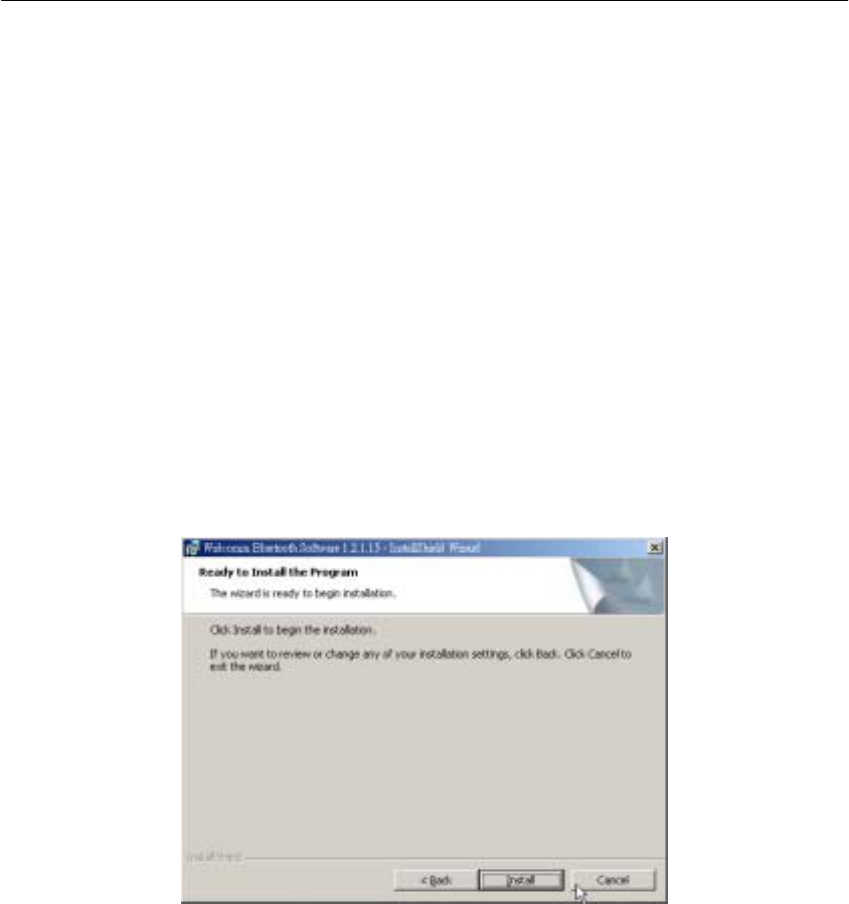
5
2 Software Installation
2.1 System Requirement
To ensure the device operate correctly, It is necessary to check your
system in the minimum requirements as described below:
♦ Windows
- Processor :Intel Celeron/Pentium III or above.
- Operation System :Windows 98SE/ME/2000/XP
- System Memory :32MB a t least
- Hard Drive Free Space :12MB
2.2 Start to installation
Step1 Insert the Software CD into CD-ROM drive. Installation
program will start automatically if the auto-run function of
CD-ROM is enabled.
If the installation program not process automatically, you can
utilize the Windows Explorer to browser CD content and run
SETUP.exe manually.
Step2 With ensuring windows appears, please click “Next” button
to continue the software installation.
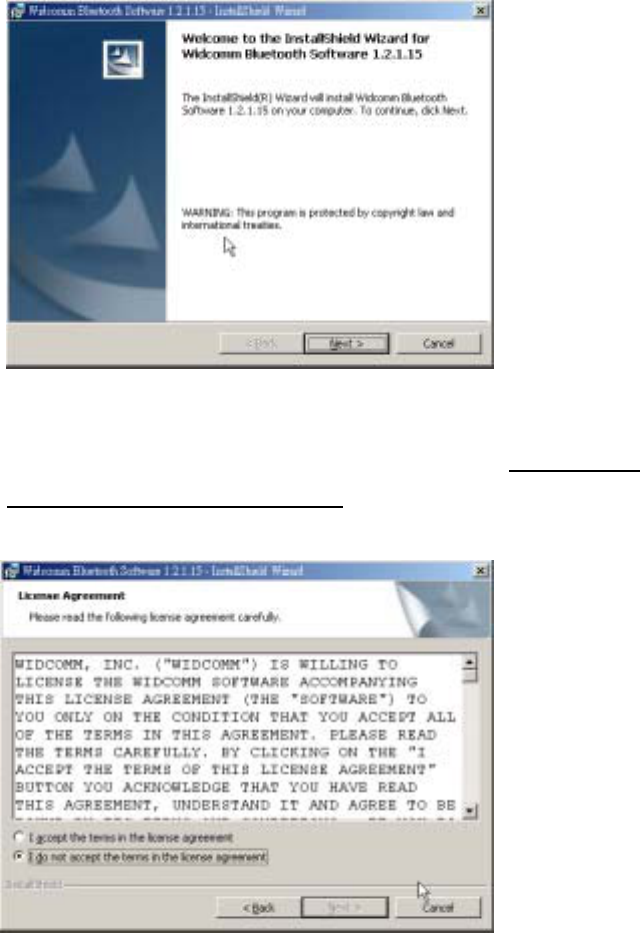
6
Step3 In “License Agreement” window, please select “I accept the
terms in the license agreement” item, and click “Next” button
to continue.
Step4 In “Device Information” window, please fill in the blank with a
name that the computer you install the Bluetooth USB
Dongle. This name will show to other Bluetooth devices in
Bluetooth environment. And in “Device Type” item, please
choose your computer type (Desktop /Laptop). Then click
“NEXT” to continue.
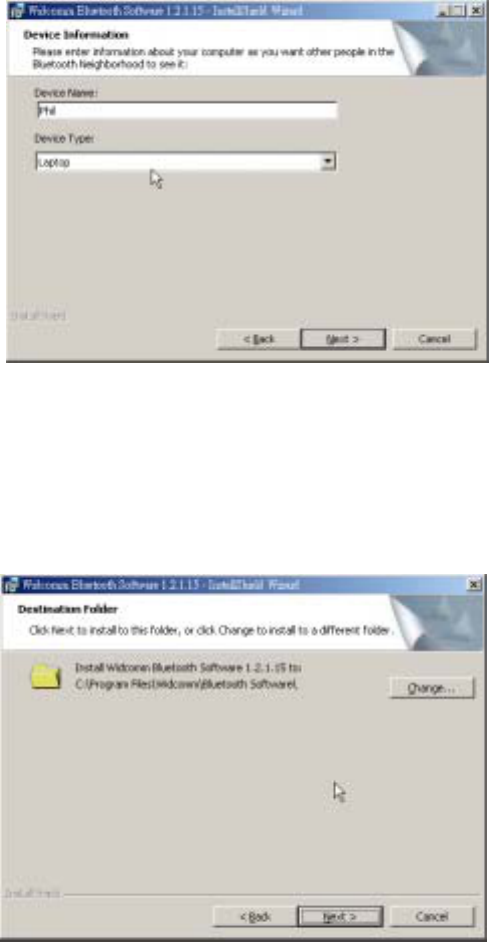
7
Step5 The software default destination folder is located in:
C:/Program File/ Widcomm/ Bluetooth Software. If you want
to change the folder, please click “Change” to select a path
you prefer.
Step6 After set the path, please click “Install” button to start
installation program.
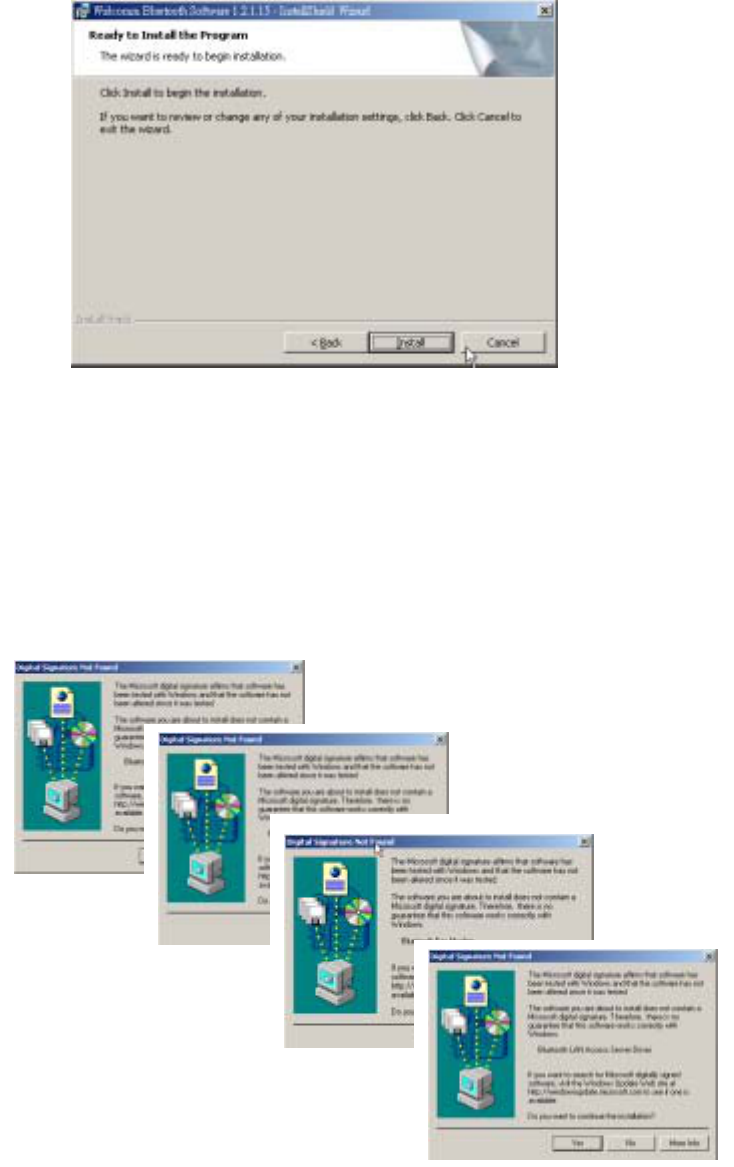
8
Step7 During the processing of the Bluetooth software installation,
it is possible to appear Microsoft Digital Signature issues
such as: Bluetooth Null Modem、Bluetooth Modem、
Bluetooth FAX Modem、Bluetooth LAN Access Server Driver.
Please confirm them manually by pressing “Yes” button from
the pop-up windows so as to finish the entire installation.
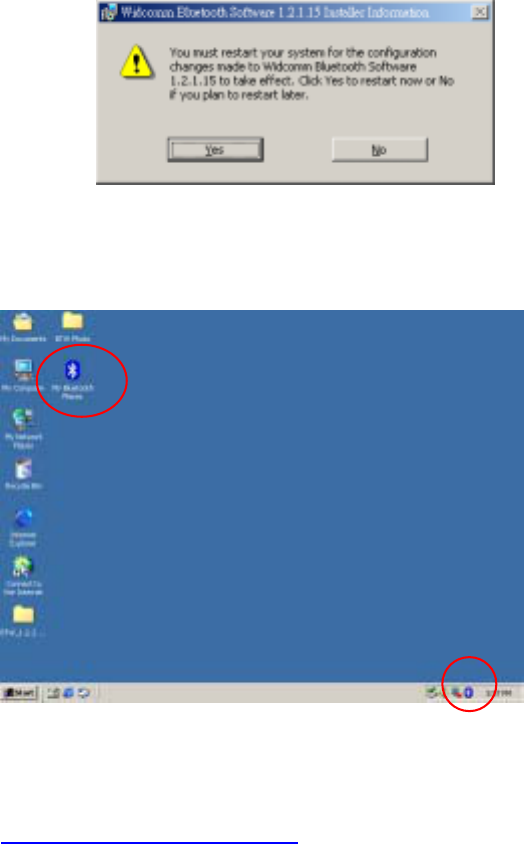
9
Step8 Please reboot your system after the software installation is
finished.
Step9 There are two Bluetooth icons appear on the desktop and
system tray after restart your computer.
Note:Under Windows 98SE or Windows ME environment. You
have to use “WinRoute Lite” software to act as a router. You
can get a downloadable trial version at:
http://www.tinysoftware.com.
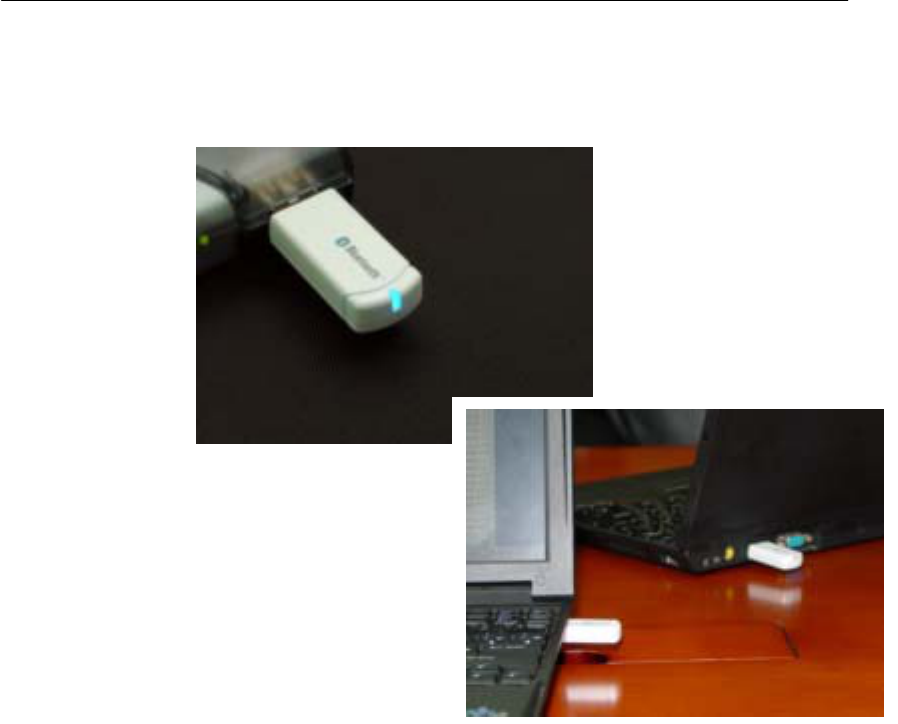
10
3 Hardware Installation
Step1 Install the Bluetooth USB Dongle to desktop or laptop that
within USB port.
Step2 You can use the Bluetooth USB Dongle at two computers or
one pc and the other one Bluetooth device.
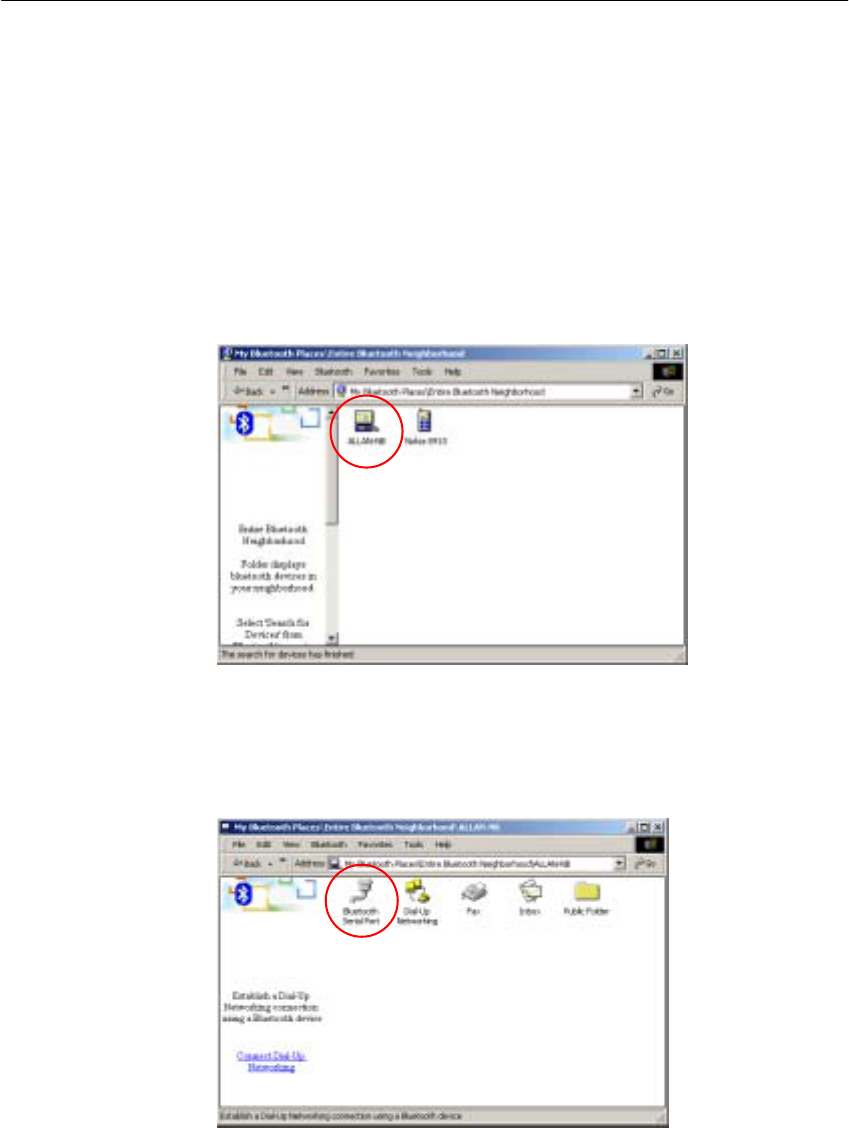
11
4 Function Description
4.1 Bluetooth Serial Port
The Bluetooth Serial Port service allows two Bluetooth devices to
establish a wireless connection through virtual communications ports
and then use that connection as if it were a hardwired serial cable
between the devices. The process as:
Step1 Select the device you want to connect at the Bluetooth
Neighborhood of Bluetooth Places. Double-click to enter the
devices’ sub-menu.
Step2 All the services that the device provides will appear.
Double-Click the “Bluetooth Serial Port” icon to start
connection.
Step3 The icon of “Serial Port” will turn to be green after the
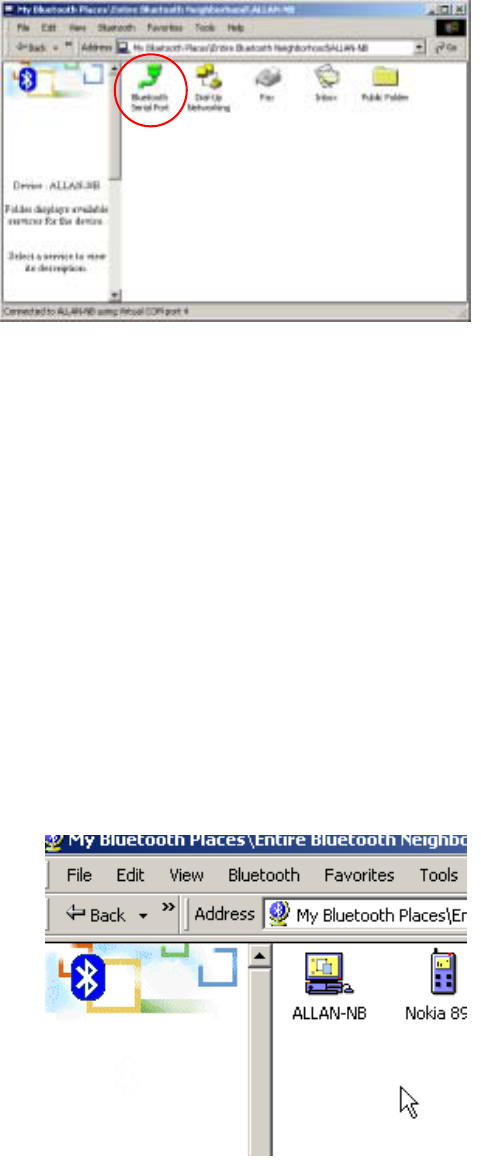
12
Bluetooth Serial Port established.
4.2 Dial-Up Networking
This service permits a Bluetooth client to use a modem that is
physically connected to a different Bluetooth device. Possible Dial-Up
Networking devices including:
- Bluetooth-enabled computer with a modem connected
- Bluetooth-enabled mobile telephone.
- Stand-alone Bluetooth-enable modems.
To establish a Dial-up Networking session, please follow the process
as below:
Step1 Select the device you want to connect at the Bluetooth
Neighborhood of Bluetooth Places. Double-click to enter the
devices’ service items.
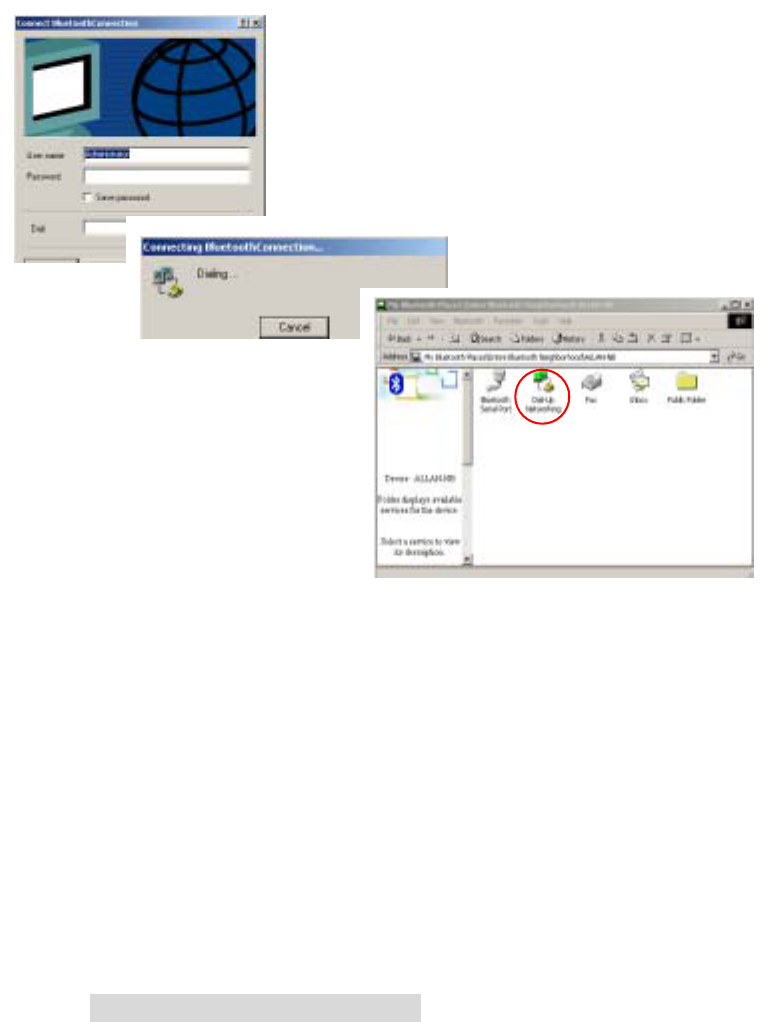
13
Step2 Double-click the ”Dial-up Networking” icon and a pop-up
dialog box appears to asking the user ID and Password.
Press the “connect” button after fill in the ID and password to
start connecting. The “Dial-Up” icon will turn to be green
color after the connection established.
4.3 Networking Access
This service permits a Bluetooth client to use a Local Area Network
connection that is physically attached to another Bluetooth device.
The possible Network Access servers include:
- Bluetooth-enabled computers that have a hardwired
Ethernet connection.
- Stand-alone Bluetooth Network Access Points.
To enable the Networking Access service allow other Bluetooth
devices, please setup the following configuration as below:
Step1 Set the “Internet Connection Sharing”
A. Configuration in Windows 2000
1. From the Windows Start/Control Panel, select
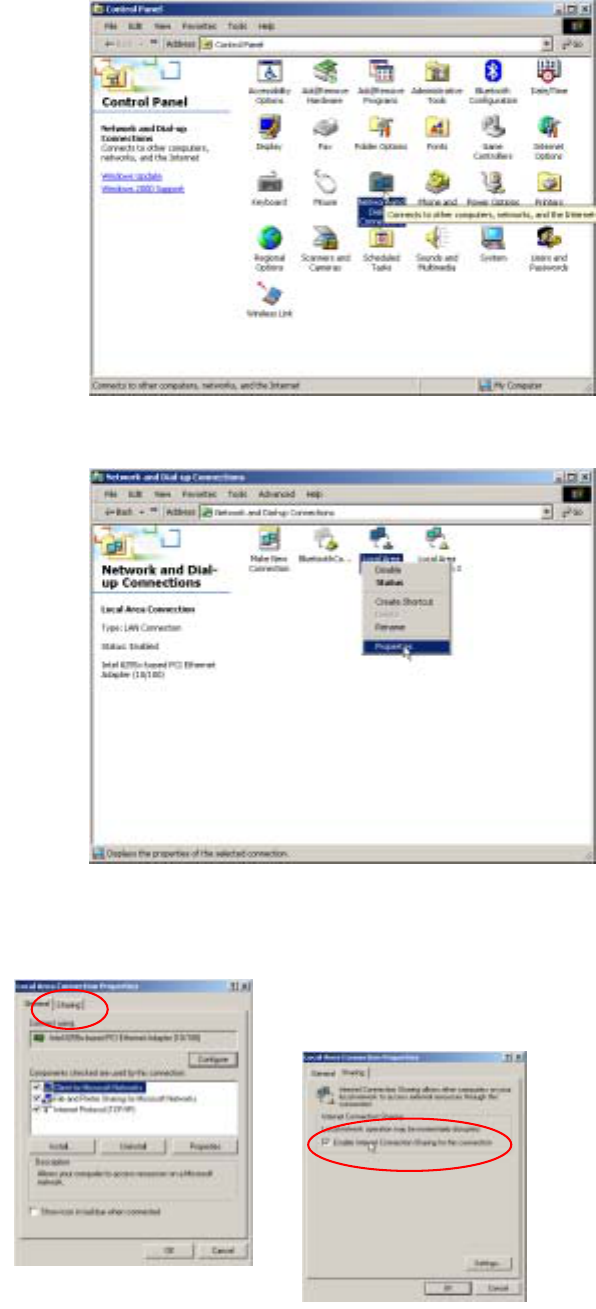
14
Networking and Dial-Up Connections icon.
2. Right-click the “Local Area Connection” icon and
select “Properties”
3. Select “Enable Internet Connection Sharing for this
connection” button in on the “Sharing” tab. And press
OK.
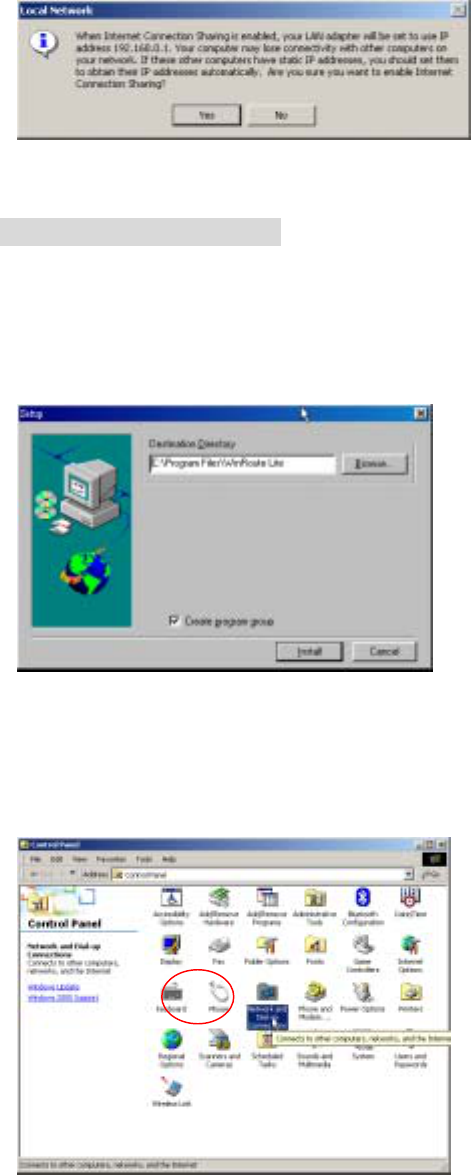
15
4. Click “Yes” button in the confirmation dialog box.
B. Configuration in Win98 SE
1. Install WinRoute Lite software(You can get a
downloadable trial version from:
http://www.tinysoftware.com), and then restart the
computer.
2. Select Windows Start/Control panel/Network to
set ”Bluetooth LAN Access Server Driver”.
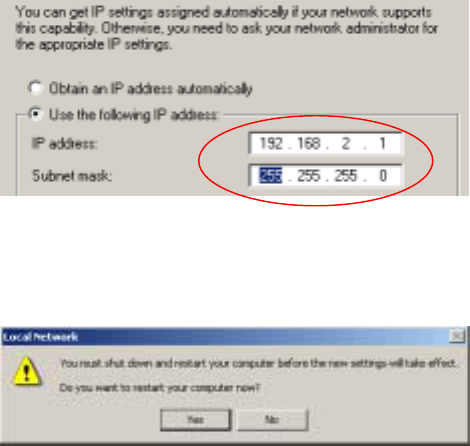
16
3. Select TCP/IP ->Bluetooth LAN Access Server
Driver, press IP address tab, select specify IP address
and enter a suggested value as :
- IP Address: 192.168.2.1
- Subnet Mask:255.255.255.0
4. Click “YES” to restart the computer
5. After restart the computer, double-click the "WinRoute
Lite Administration” icon in the windows system tray,
and select “Setting” tab”
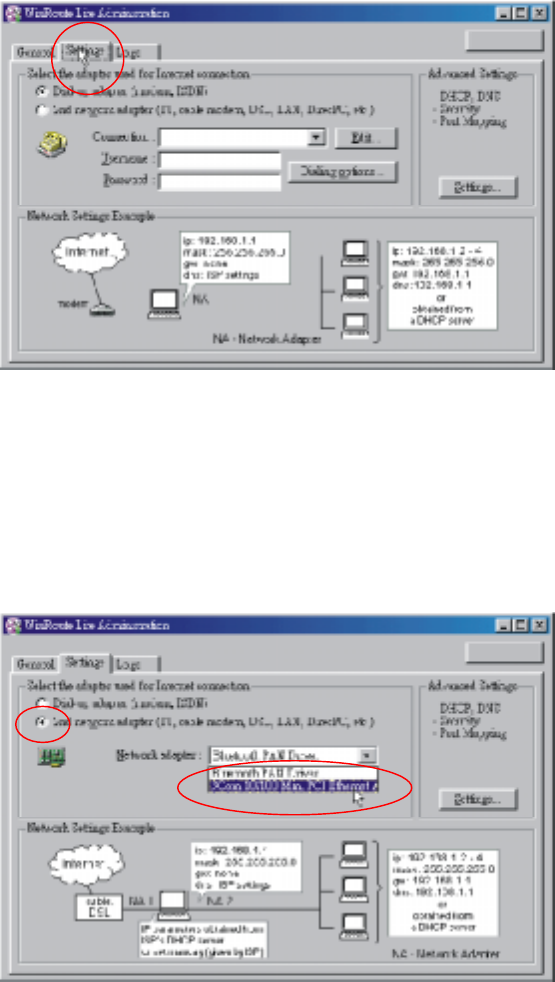
17
HELP
6. In the “Setting” tab, select「2nd networking adapter」,
and choose one network adaptor other than Bluetooth
PAN Driver from the Networking adaptor drop-down
list.
HELP
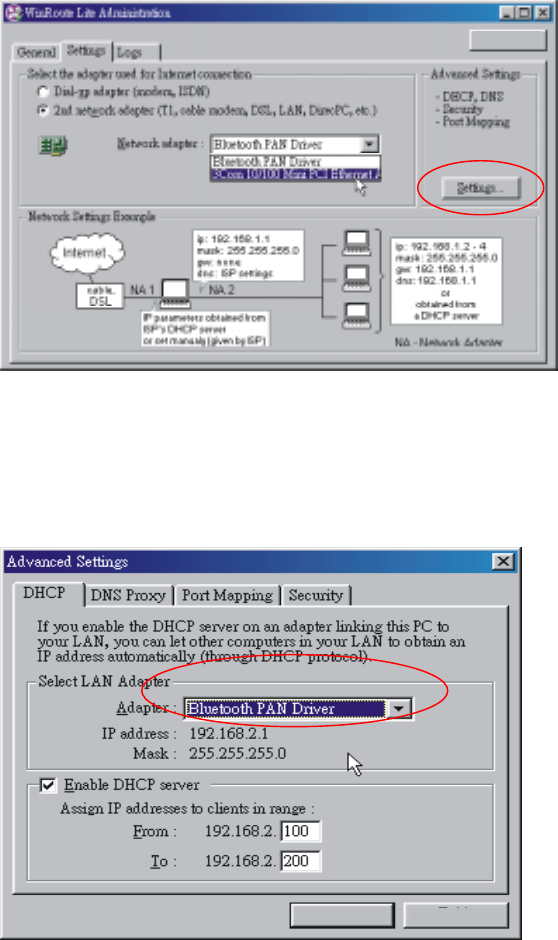
18
7. Press “Setting…” button in the Advanced Setting
section in the right side of same tab.
HELP
8. In the “DHCP” tab, select “Bluetooth PAN Driver from
the “Select LAN Adapter” drop-down list.
OK
Cancel
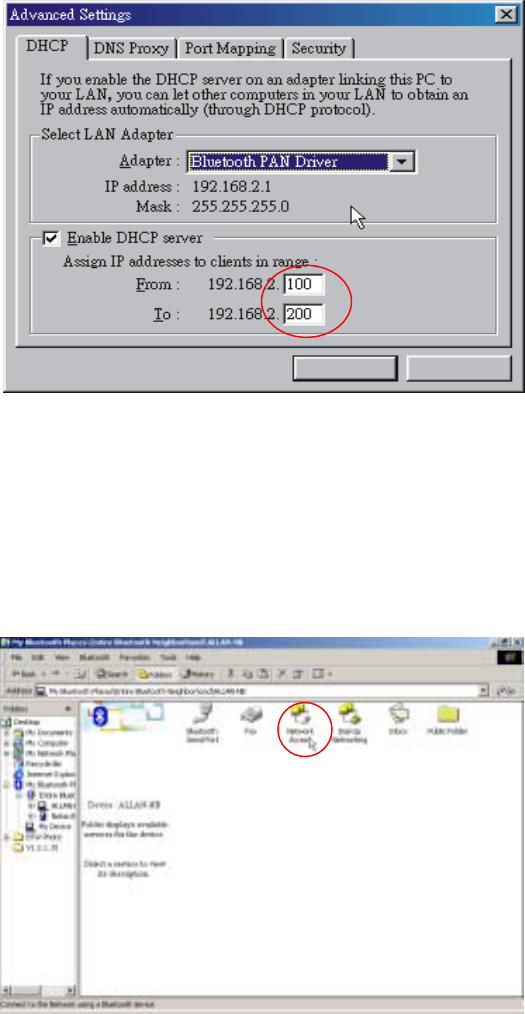
19
9. Select “Enable DHCP server”, and fill in the IP
address range fields:
From: 192.168.2.100
To: 192.168.2.200
OK
Cancel
Step2 Select the device you want to connect at the Bluetooth
Neighborhood of Bluetooth Places. Double-click to enter the
devices’ service items.
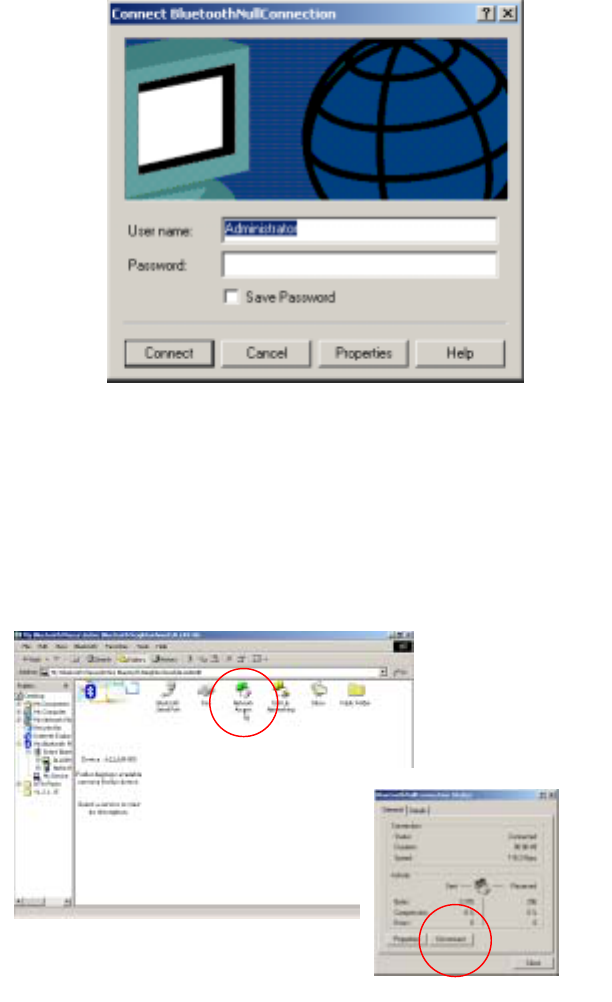
20
Step3 Double-click at “Networking Access” icon to start to
communicating to others Bluetooth enable devices, a pop-up
dialog box appear to asking ID and Password, press
“Connect” button after fill in ID and Password.
Step4 When the connection is established, the “Network Access”
icon will turn to be green color. And the system tray will show
the status of connection. You can double-click the icon when
you want to disconnect a Network Access service.
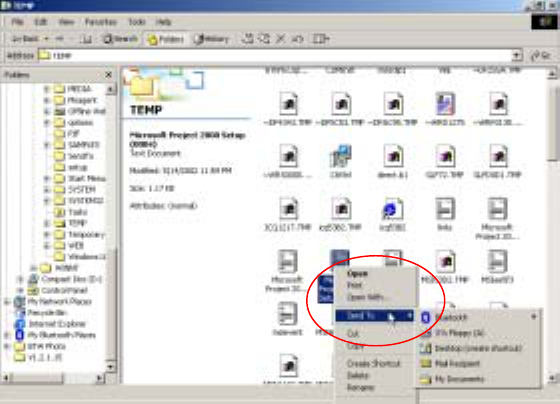
21
4.4 File Transfer
This service allows one Bluetooth device to perform file operations on
the default File Transfer directory (and the folders and files it contains)
of another Bluetooth device. Select one file you want transfer and
right-click to choose “Transfer to” from the pop-up menu to transfer
file.
4.5 Information Exchange
This service provides a way to send and receive Microsoft Outlook
items to and from another Bluetooth device, such as: Business cards,
Calendar entries, Notes and Messages etc. Select the device you
want to connect at the Bluetooth Neighborhood of Bluetooth Places.
Double-click to enter the devices’ service items. And right-click to
select the service you want: Send, Receive or Exchange.
22
4.6 Information Synchronization
This service provides information synchronization between two
Bluetooth devices (e.g., a PIM database). Microsoft Outlook is the
only PIM supported in this release of BTW. Only Outlook’s default
contacts folder is synchronized. Items in sub-folders are not
synchronized.
You can follow the process as below to use Information
Synchronization:
Step1 Select the device you want to connect at the Bluetooth
Neighborhood of Bluetooth Places. Double-click to enter the
devices’ service items.
Step2 Double-click at “Information Synchronization” icon to star
synchronization. There is a dialog box display
synchronization progress, when the process is complete,
indicates that synchronization has successfully completed.
And the connection will close automatically when
synchronization is complete.
4.7 Fax
The Fax service allows a Bluetooth client to wirelessly send a fax
using a device that is physically attached to a Bluetooth server:
Step1 Select the device you want to connect at the Bluetooth
Neighborhood of Bluetooth Places. Double-click to enter the
devices’ service items.
Step2 Double-click at “Fax” icon to establish connection, and then
you can send the Fax via fax application or use the “Print”
and “Send to Fax Recipient.
Step3 The service will closes automatically when the transmission
is completed
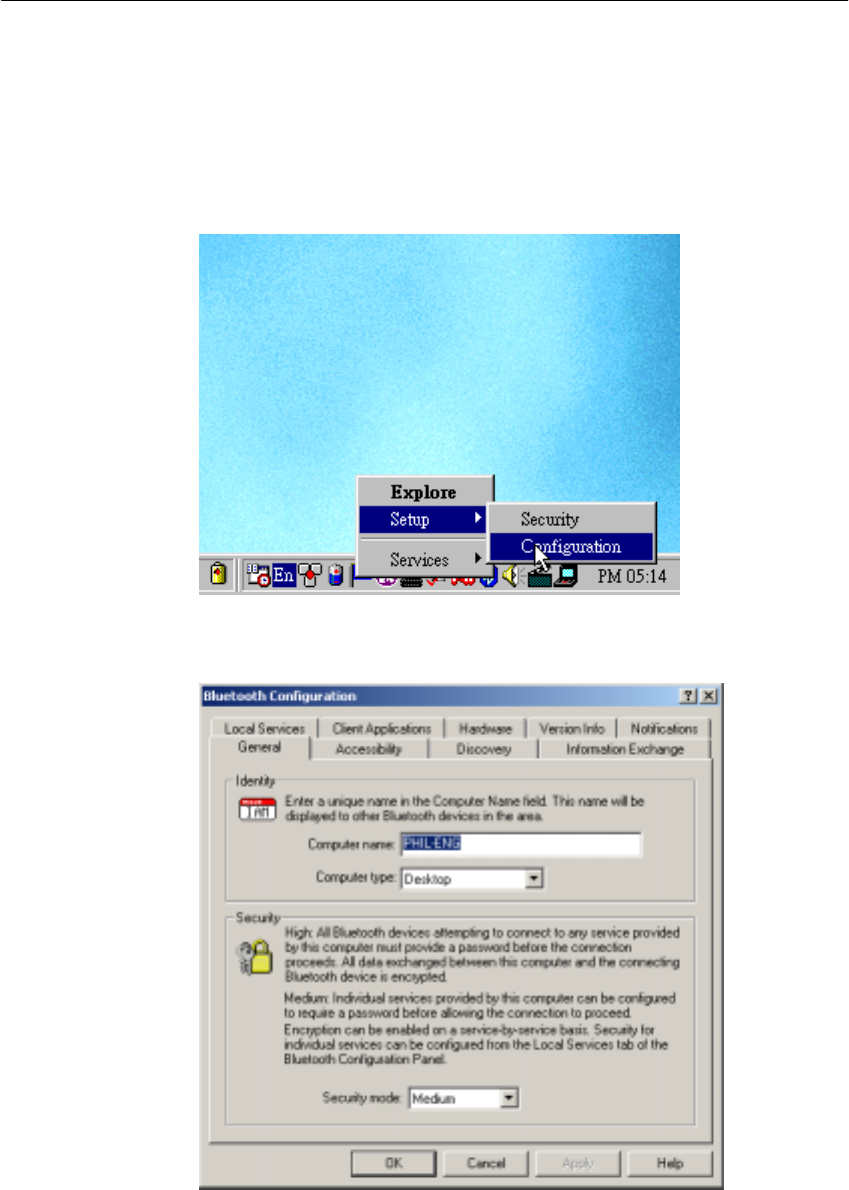
23
5 Bluetooth Software Configuration
After install the Bluetooth software(BTW), you can see the Bluetooth icon
at windows system tray after restart the computer. Right-click the icon and
select Setup and then Configuration from the submenu to settings for
Bluetooth services, hardware and security and for event notification that
describe as follows:
5.1 General
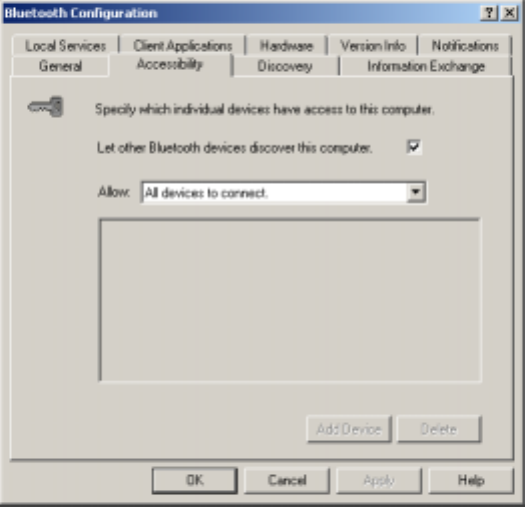
24
- Identity
In this section, you can set your computer name at “Computer
Name” column to introduce this computer to others Bluetooth
devices. A valid computer name is between 1 to 247
characters.
Besides, you can select the type of your computer type:
Desktop or Laptop.
- Security
In this section, there are two degrees to choose: Medium or
High.
5.2 Accessibility
- You can let other Bluetooth devices discover your device if the
button “Let others Bluetooth devices discover this computer” is
selected.
- There are four configuration at this option in drop-down list to
selected:
♦ No devices to connect
Your computer can still connect other Bluetooth devices, but
others Bluetooth devices cannot connect your computer or
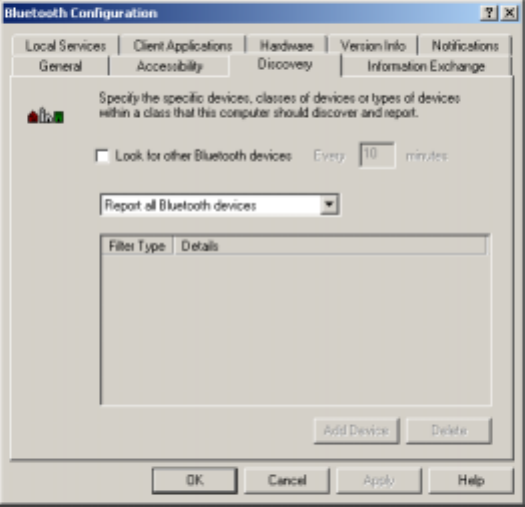
25
use all services.
♦ All devices to connect
Default setting, it allow all Bluetooth devices connect to this
computer.
♦ Only paired devices to connect
Only the devices, which have been paired, are allows
connecting this computer.
♦ Only devices listed below to connect
Only the devices, which list in “Add Devices” box, are allows
connecting this computer
5.3 Discovery
- The settings determine whether your computer looks for other
Bluetooth devices automatically and how often it looks and what
type of devices it looks for. To perform a periodic search for
devices: when "Look for other Bluetooth devices" is selected,
BTW automatically searches for devices every “X” minutes. X is
an integer from 1 to 60.
- There are two modes on drop-down list:
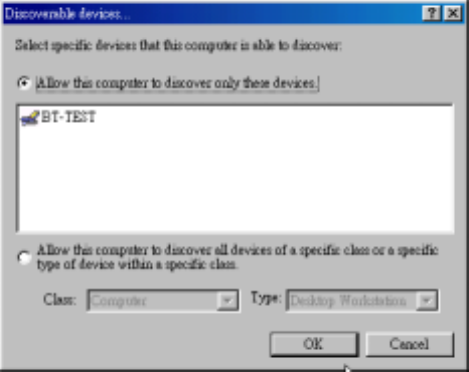
26
♦ Report all Bluetooth devices – its system default option, the
Bluetooth Neighborhood windows will display all devices found
by your computer.
♦ Report only selected Bluetooth devices – you can set filter by
pressing “Add device” button.
a. Allow this computer to discover specific devices
Check the “Allow this computer to discover specific
devices” button is selected, and pressing OK after
selected the Bluetooth device that show in filter list
dialog box.
b. Allow this computer to discover specific or type of
devices within a class
Check the “Allow this computer to discover specific or
type of devices within a class” button is selected, and
pressing OK after selected others Bluetooth devices’
type.
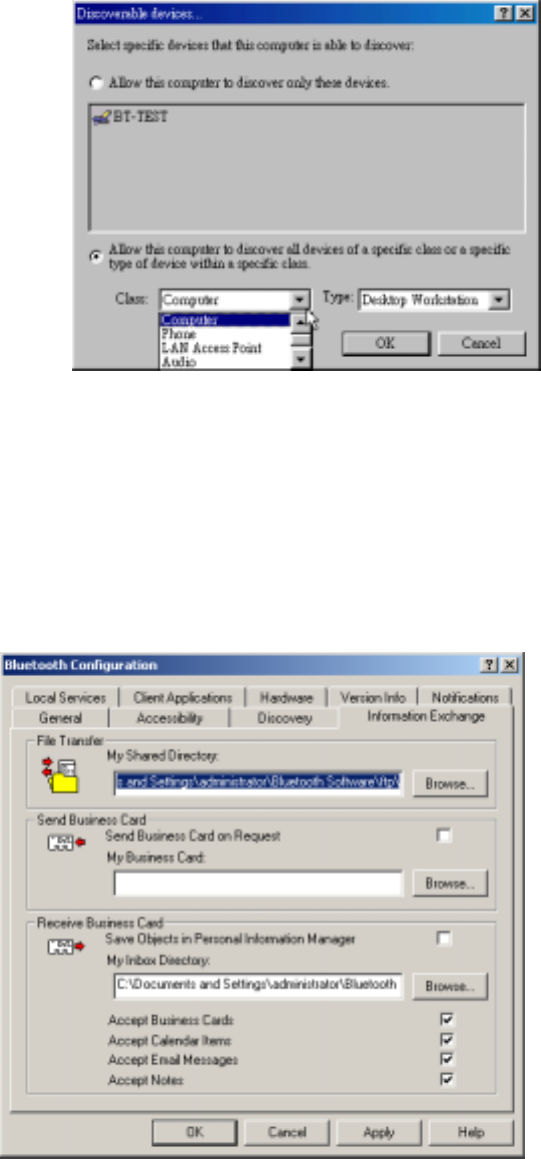
27
5.4 Information Exchange
- At the column of File Transfer, Click the Browse button and
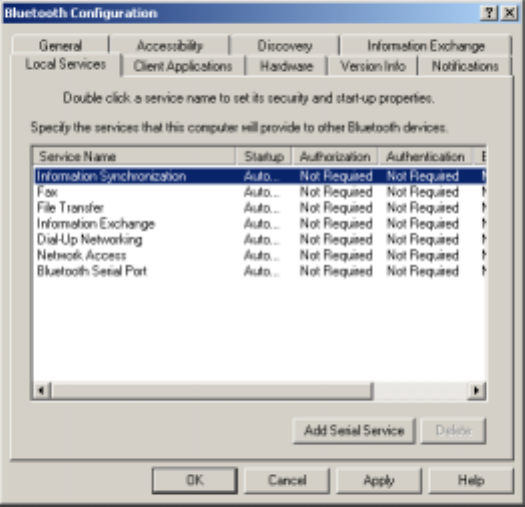
28
navigate to the directory that will be used as My Shared
- Select the "Send Business Card on Request" option to allow
remote devices to obtain your business card. Click the Browse
button and navigate to the directory that contains your business
card.
- Select the "Save Object in Personal Information Manager" option
to save incoming objects directly in the PIM, and then click the
Browse button to navigate to the directory where they should be
saved.
5.5 Local Service
- You can choice the configuration of the services provided by your
computer to remote devices. And add and delete user-defined
serial services.
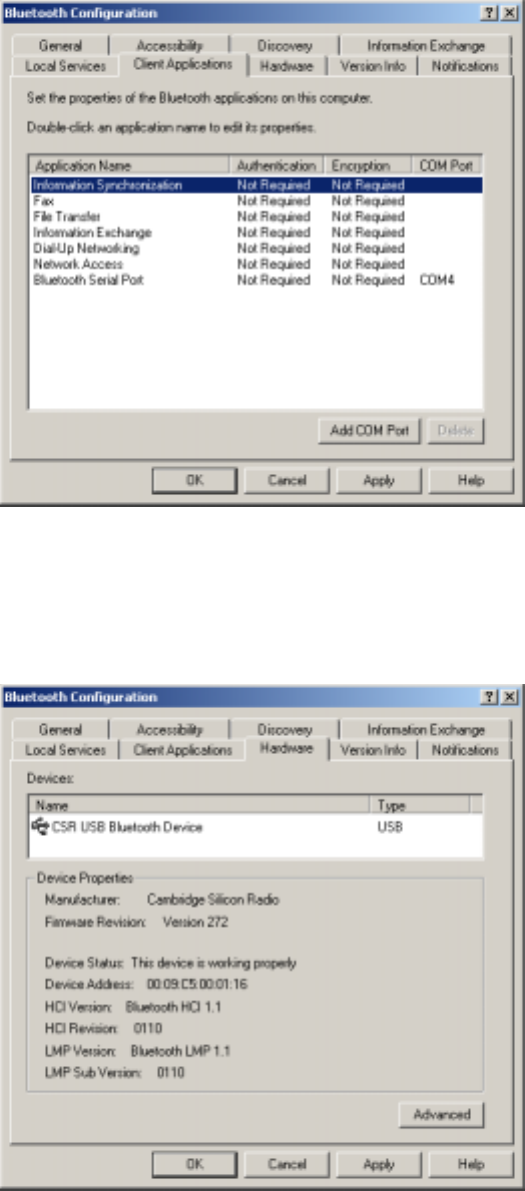
29
5.6 Client Application
- This tad allows you to set Bluetooth Devices’ security, application
name or add/delete a user-defined COM port.
5.7 Hardware
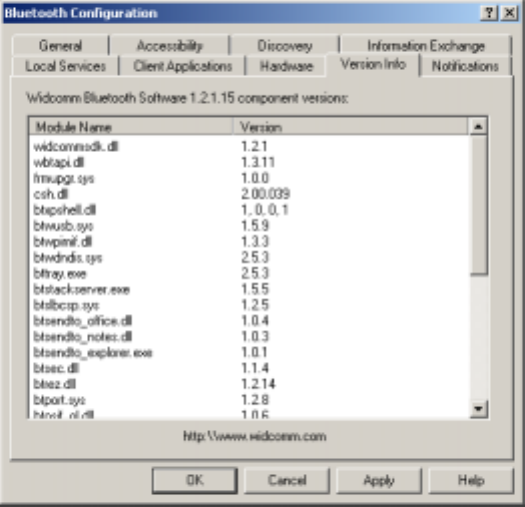
30
- This tab shows information of Bluetooth Device in local computer.
You can change transmission power at “Advance” setting.
5.8 Version Info
- Shows version number information.
5.9 Notification
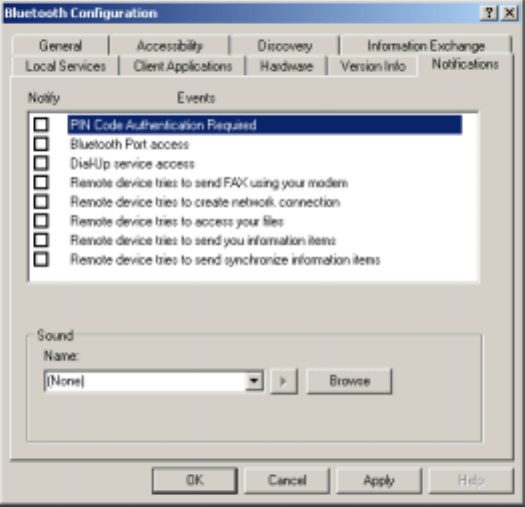
31
- You can choice sound notice for each service, Just dial “Browser”
bottom to set sound.

32
6 Others
6.1 Mac user reference
- This product provides the function of file transmission between
two Mac PC via Bluetooth or dial-up to access Internet via
Bluetooth mobile phone.
- Try to download the application software here: www.apple.com,
and refer to the user guide.
FCC-B Radio Frequency Statement
This equipment has been tested and found to comply with the limits for a class B
digital device, pursuant to part 15 of the FCC rules. These limits are designed to
provide reasonable protection against harmful interference when the equipment is
operated in a commercial environment. This equipment generates, uses and can radiate
radio frequency energy and, if not installed and used in accordance with the instruction
manual, may cause harmful interference to radio communications. Operation of this
equipment in a residential area is likely to cause harmful interference, in which case
the user will be required to correct the interference at his own expense.
Notice 1
The changes or modifications not expressly approved by party responsible for
compliance could void the user’s authority to operate the equipment.
Notice 2
Shielded interface cable and A.C. power cord, if any, must be used in order to comply
with the emission limits.
FCC RF Radiation Exposure Statement:
1. This Transmitter must not be co-located or operating in conjunction with any
other antenna or transmitter.
1. This equipment complies with FCC RF radiation exposure limits set forth for an
uncontrolled environment. This equipment should be installed and operated with a
minimum distance of 20 centimeters between the radiator and your body.